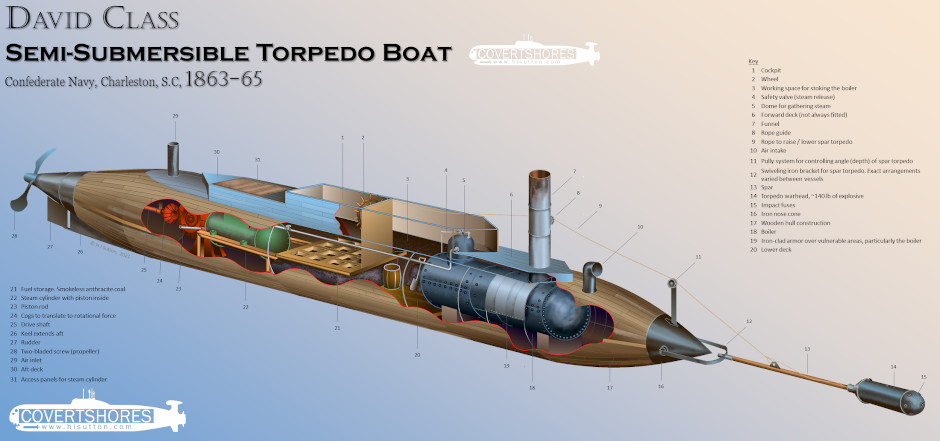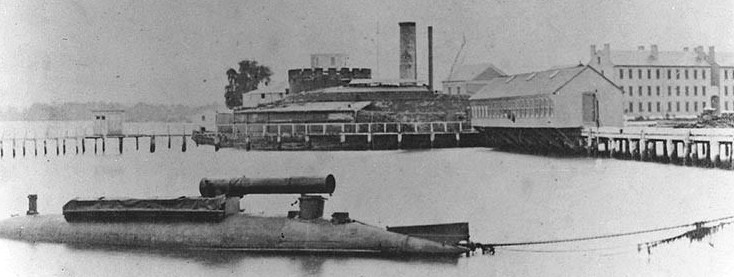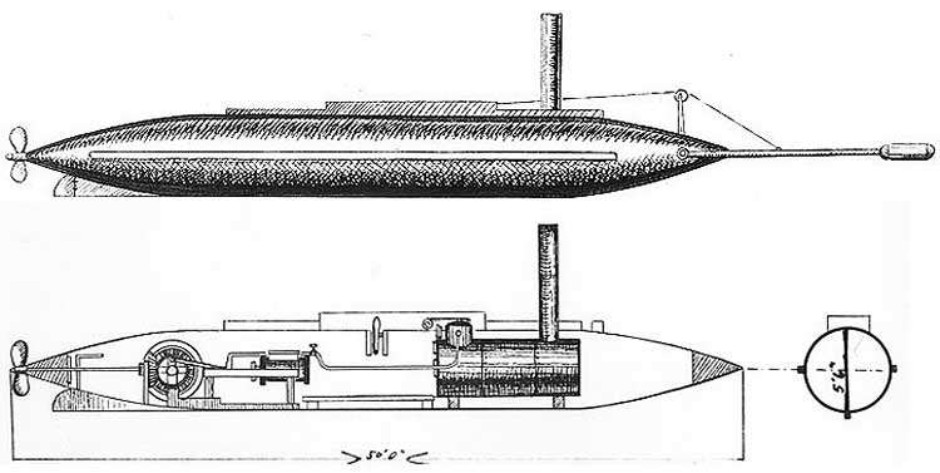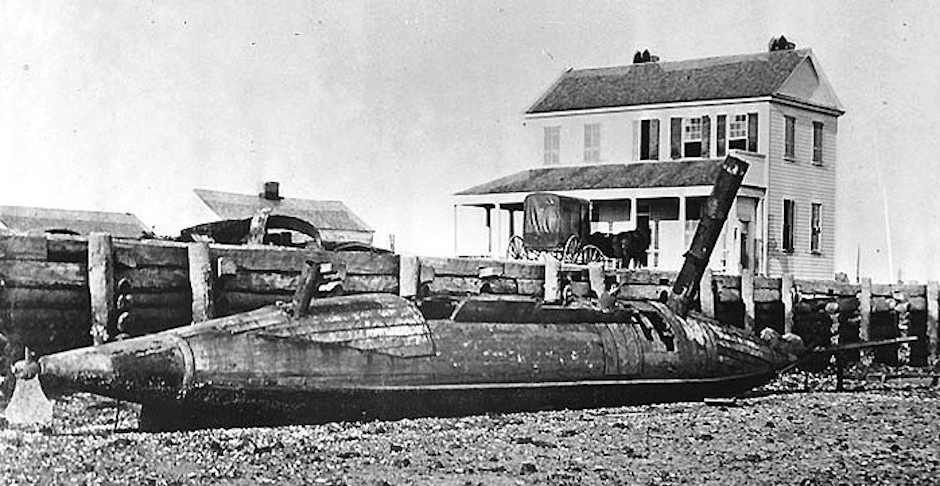![]()

![]()


Original artwork - CLICK for HIGH-RESOLUTION image.
The Rebel Ram Of The Civil War: David Class Semi-Submarine
The David Class is a semi-submersible torpedo ram developed by the Confederate side during the American Civil War. It was conceived to defend Charleston, South Carolina, from Union blockade ships. Objectively, it is a fascinating concept which can be viewed as of the precursors to today's semi-submersibles.
Semi-submersibles are a less well known than submarines, but they are becoming increasingly popular with Special Forces. The basic principle is to take a normal boat and add internal tanks that can be flooded like a submarine so that it starts to sink. Solid ballast can also be used. The trick is to only sink it up to level of the deck, so that some of the craft always remains above the water.

It is technically still a surface vessel. Yet by running “awash” (level with the surface of the water so that waves sometimes break over the deck), it presents a very small visual signature. This also makes it hard to hit with gunfire. Additionally his mode of operation allows the top to be open to the sky so that the crew don’t run out of air. This also simplifies many of the navigation and technical challenges of submarines.
Although nearly 90 years after David Bushnell built the famous Turtle during the War of Independence, the David was still before submarines as we know them today. Others, including several on the Confarreate side, were experimenting with fully submersed vessels. The most famous of these was the H.L. Hunley. But at the time these had to be human-powered which greatly limited their effectiveness. The David Class however could use a steam engine making them much more practical.
Learn EVERYTHING about Special Forces subsCovert Shores 2nd Edition. A world history of naval Special Forces, their missions and their specialist vehicles. SEALs, SBS, COMSUBIN, Sh-13, Spetsnaz, Kampfschwimmers, Commando Hubert, 4RR and many more.
Check it out on Amazon
The first boat was built in 1863 by St. Julien Ravenel. It was named the CSS David and described as a “torpedo boat”. This was because they used a 134lb (60kg) warhead mounted on a long spar from the front of the boat. The term ‘torpedo’ really just meant an explosive charge used against ships. The self-propelled ‘torpedoes’ we know today were not even invented until a few years later.

Design
The Davids were built of wood and had a generally cylindrical hull with conical ends, a shape popular with submarines up until the 1900s. Like a submarine a single screw was mounted in the tail. Where they differed from submarines was that they had a steam boiler towards the front with a large chimney and inlets sticking up in the air. Behind this was an open cockpit for the four-man crew. The craft was about 50ft (15m) long without the warhead spar, which added another 10ft (3m). The spar hinged at its base and could be lifted by pulleys from within the craft, a vital safety consideration.

Get The essential guide to World Submarines
This Covert Shores Recognition Guide Covers over 80 classes of submarines including all types currently in service with World Navies.Check it out on Amazon
The basic mission profile was to attack at night while running awash, and ram the target at high speed. The speed of the impact allowed the warhead to be embedded in the target, where it is released from the attacking craft and detonated after the craft has backed off to a safe distance. Detonation was generally by means of a rope attached to a spring-loaded trigger, although there is some evidence that some may have been electrically triggered. Some sources indicate that some of the torpedoes may have had impact fuses instead.
The Attack on USS New Ironsides
In practice this arrangement was quite credible.
A famous attack was made on the Union warship USS New Ironsides on the night of 5th October 1863. The CSS David approached its Goliath as she lay at anchor,. The low silhouette and use of smokeless fuel allowed the David to get within 50 yards (45m) before being detected. Within seconds the David rammed the charge into the ironclad and backed off before triggering the explosives.

That much had gone to plan, but the explosion created a large water plume which came down on the David and went down the funnel, putting her steam boiler out. More water bucketed into the hull via the open top of the pilot station. Fearing she was sinking some of her crew abandoned ship, but the engineer who could not swim remained aboard awaiting his fate. When it became apparent that she was not going to sink, some crew reboarded her. They managed to relight her boiler and make their escape, leaving a few stranded colleagues to be captured. When the dust and spray settled it was found that their ironclad target was largely undamaged but the attack was deemed a success, or at least a proof of concept.
Significance
Several more David-class torpedo boats were built, with some being twice as long, and one or two even three-times as long as the original. It is not known how many were built or what their names were. The sister ships did not repeat the David’s success but their existence proved a menace for the Union Navy.
As well as being a precursor to more recent Special Forces semi-submersibles, the David design of spar torpedo boats was also a precursor to explosive motorboats.
The World's ONLY Guide to
Narco Submarines
10 years of research, analyzing over 160 incidents, condensed into a handy guide. This unique book systematically breaks down the types and families. With detailed taxonomy, recognition 3-views, profiles and photos. Available on Amazon
Related articles (Full index of popular Covert Shores articles)

 American Civil War submarine H. L. Hunley
American Civil War submarine H. L. Hunley

 Delfin Class, Cuba's only submarine. w/Cutaway
Delfin Class, Cuba's only submarine. w/Cutaway

 1913 Patent for a Submarine w/Cutaway
1913 Patent for a Submarine w/Cutaway

 Iranian Fateh Class submarine w/Cutaway
Iranian Fateh Class submarine w/Cutaway

 World war One Type UC-1 U-boat w/Cutaway
World war One Type UC-1 U-boat w/Cutaway

 Surcouf Cruiser Submarine w/Cutaway
Surcouf Cruiser Submarine w/Cutaway

 Type-IIIA U-Boat
Type-IIIA U-Boat
 Explosive Boats world history
Explosive Boats world history
 Narco Subs 101. w/Cutaway
Narco Subs 101. w/Cutaway
 LTTE Sea Tigers' sneak craft and midget subs
LTTE Sea Tigers' sneak craft and midget subs













 World guide to Heavyweight Torpedoes
World guide to Heavyweight Torpedoes

 Prohibition era Moonshine smuggler's sub. w/Cutaway
Prohibition era Moonshine smuggler's sub. w/Cutaway
 The Escape of Bernd Boettger from East Germany
The Escape of Bernd Boettger from East Germany
 Nautilus 2020 Luxury Private Submarine. w/Cutaway
Nautilus 2020 Luxury Private Submarine. w/Cutaway
 Cutaway of Jules Verne’s Nautilus. w/Cutaway
Cutaway of Jules Verne’s Nautilus. w/Cutaway
 Turbinia, the first steam turbine boat (1894)
Turbinia, the first steam turbine boat (1894)
 Armored Stealth Boat used for car smuggling by Chinese organized crime. w/Cutaway
Armored Stealth Boat used for car smuggling by Chinese organized crime. w/Cutaway





